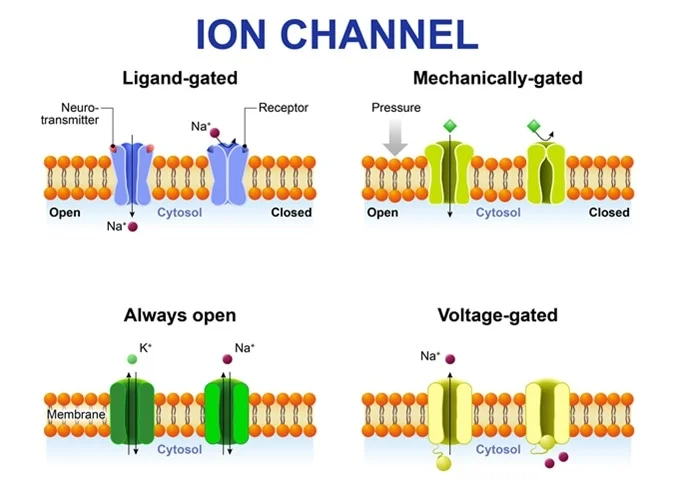Explain the Different Types of Ion Channels
Explain and recognize each step of how an action potential is 1 transmitted and 2 propagated. The open conformation of the ion channel allows for the translocation of ions across the cell membrane while the closed conformation does not.

Types Of Ion Channels In The Body
The mechanically gated channels that are ion channels whose pore responds to mechanical stimuli.

. Respond to changes in the cells membrane potential. Like the bacterial Kchannel the membrane-spanning domains of all ion channels appear to form a central porethrough which ions can diffuse Figure 48. Channels for anions negative ions will have positively charged side chains in the pore.
The ligandgated channels that are regulated by ligands ie chemicals that bind to it. Narrow highly selective ion channels mimic the water environment by lining the conducting pore with polarized carbonyl oxygen atoms. Hormone Signaling Via G ProteinCoupled.
These ion channels are sensitive to the environment and can change their shape accordingly. Distinguish between types of ion channels. On the basis of localization ion channels are classified as.
Stimulated by physical pressure 2 Chemically gated ion channels. Naand Ca2 channel subunits cross the membrane 24 times Figure 47AB and the channel is evidently formed by just one of these Naor Ca2channel subunits. Other K selective channels with pore-forming P domains.
As the name implies the activity of voltage-gated channels is regulated by changes in the transmembrane. 1 Ligand-gated ion channels open when a chemical ligand like a neurotransmitter binds to the trans-membrane protein. Voltage-gated potassium channels Kv Sodium channels Nav Calcium channels Cav.
Ion channels can also be specified by the diameter of the pore. In fact a majority of ion channels fall into these two broad categories. Other channel types require either three or five homologous subunits to generate the central conducting pore.
In solution ions are stabilized by polarized water molecules in the surrounding environment. Primary transporters symporters and antiporters are the three types of transporters. There are different types of transporters including pumps uniporters.
Less-selective channels form pores. Plasma membrane channels Examples. Some ion channels need to be activated in order to open and allow ions to pass into or out of the cell.
Gastrointestinal Hormones and Neurotransmitters. Hint you should be drawing this out 5x and explaining each step from the presynaptic neuron axonal terminal to the postsynaptic neuron axonal terminal Explain the role of calcium and where it is used in the AP. Ion Channels Are Selective Ion channels are selective.
Open closed and inactive as illustrated in Figure 1. Along the axon are voltage-gated sodium ion and potassium ion channels. Channels for cations positive ions will have negatively charged side chains in the pore.
1 Mechanically gated ion channels. Similarly various mutations are now being linked to CPVT including mutations in RyR2 CASQ2 CALM1 and KCNJ2 Kir21. Ion channel coupled receptors are involved in rapid signaling between.
Voltage-gated potassium channels Kv Sodium channels Nav Calcium channels Cav and Chloride. Of note mutations in different ion channels often lead to the same pathological phenotype. Voltage-gated ion channels are a class of transmembrane proteins that form ion channels that are activated by changes in the electrical membrane potential near the channel.
This is called electrochemical exclusion meaning that the channel pore is charge-specific. Ion channels come in many different types some of which are selective for specific types of ions such as K Na and Ca 2. Either passive or active 3.
These channels belong to one superfamily and carry pivotal roles such as the propagation of neuronal and muscular action potentials and the promotion of neurotransmitter secretion in synapses. In a neuron chemically gated ion channels are present on the dendrites and cell body. For example mutations in genes encoding Kv Nav and Cav channels can all lead to AP prolongation and manifest as LQTS.
Voltage-gated ion channels and ligand-gated ion channels are two types of gated ion channels. Stimulated by Nt 3 Voltage-gated ion channels. Ion channels can be 1 voltage-sensitive 2 ligand-gated or 3 respond to physical stimuli.
They allow some ions to pass through and prevent the passage of others. Depending on the factor s that produce their opening and closing gating ion channels are classified into four types. Functionally unique Page 4.
Ligand-gated ATP activated Cl- channels. Summarize the different neuron. Voltage-gated ion channels are large transmembrane proteins that enable the passage of ions through their pore across the cell membrane.
Na K Ca2 and Cl ions mostly move through ion channels. Voltage-gated calcium ion channels are located at axon terminals. The channels are.
Ion channels control the movement of ions through the neuronal cell membrane. Ion channels can be either non-gated or gated. Ion Channel Ion Channels.
Ion channels that change their structure in response to voltage changes are called voltage. Voltage-gated ion channels ligand-gated ion channels and aquaporins are the three types of ion channels. In biology a transporter is a transmembrane protein that moves ions or other small molecules across a biological membrane to accomplish many different biological functions including cellular communication maintaining homeostasis energy production etc.
The voltage-gated channels that are gated by changes in membrane potential. Voltage-gated Na and K channels play an important role in the initiation and conduction of electrical signals along the axon. Ligand-gated channels activated by ACh GABA or Gly.
Ion channels have different configurations.

Gated Ion Channels Biosignalling Mcat Content

No comments for "Explain the Different Types of Ion Channels"
Post a Comment